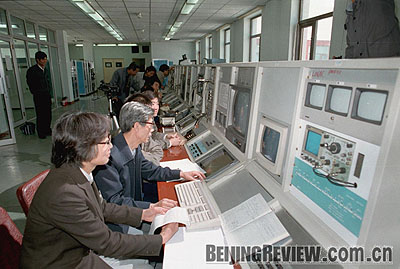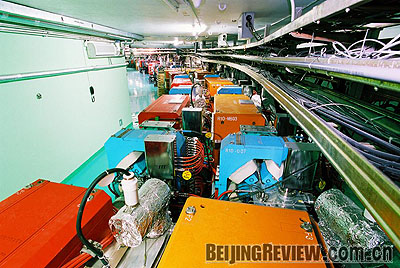|

PARTICLES COLLIDE: On October 16, 1988, an electron-positron collider achieves the first successful collision of high-energy particles
Four years ago, on April 30, 2004, the Beijing Electron-Positron Collider (BEPC) finished its last high-energy physics experiment. That did not mean that it would be put out of service. Rather, 640 million yuan ($93.8 million) would be spent upgrading it to BEPC II, a collider 100 times more powerful. Now, the retooling process is about to be completed.
The advanced equipment is a "microscope" to observe the infinitesimally small micro-world that will disclose the mysterious microstructure of matter. In a collider, particles such as electrons, positrons and protons are stored in circular vacuum storage rings, propelled to travel in opposite directions at the speed of light, and set to collide at collision points. By studying the collision of high-energy particles, scientists expect to discover new particles or new phenomenon.
If particles in the accelerator bombard a stationary target, the power generated is not as much as those produced when particles collide with each other head on. This understanding inspired scientists to upgrade the colliders developed in the 1970s to generate particles moving in opposite directions. At present, about a dozen upgraded colliders have been built around the world.
 MORE POWERFUL: The double storage ring of the upgraded Beijing Electron-Positron Collider II
MORE POWERFUL: The double storage ring of the upgraded Beijing Electron-Positron Collider II
BEPC looks like a huge badminton bat, and consists of an injector, storage ring, the Beijing Spectrometer (BES) and the Beijing Synchrotron Radiation Facility (BSRF). The 200-meter long linear injector is an accelerator, generating electron and positron beams with beam energy ranging from 1 to 1.55 GeV. The electrons and positrons are injected into the ring. The BES is a detector built around the collision point that records the energy and momentum of particles born during the collision. The BSRF induces the synchrotron radiation produced when positrons pass through bending magnets and wigglers into the synchrotron radiation laboratory.
The basic structure of BEPC II has not changed much from BEPC. The retooled collider consists of two long storage rings, one for electrons and one for positrons. The storage ring is the heart of a collider. The particles collide at the interaction point with a horizontal crossing angle. Each ring holds 93 bunches.
Luo Xiao'an, a research fellow at the Institute of High Energy Physics (IHEP), explained that after the retooling, the collider will be 100 times more powerful, which means that it will be capable of collecting as much data in one day as the old one did in 100 days.
The removing and reinstallation of the storage ring is the toughest part of the retooling project. Two-ring collider usually has a perimeter of 2,000 meters, although in Europe, some colliders have a perimeter of 27,000 meters. The parameter of BEPC is only 240 meters. To put two storage rings in such a narrow tunnel is very difficult.
"Much of the equipment and technology used for the retooling has not been seen in China before, and the colliders used in high-energy physics require more processing precision than most equipment used in the aerospace industry," said Chen Hesheng, head of IHEP and an academician at the China Academy of Sciences (CAS).
| 